Joanna I of Anjou (1325–1382), countess of Provence and the fourth sovereign of the Angevin dynasty in south Italy (since 1343), became the heir to the throne of the Kingdom of Sicily, succeeding her grandfather King Robert “the Wise” (1277–1343). The public and official images of the queen and the “symbolic” representations of her power, commissioned by her or by her entourage, contributed to create a new standard in the cultural references of the Angevin iconographic tradition aiming to assimilate models shared by the European ruling class. In particular, the following works of art and architecture will be analyzed: the queen’s portraits carved on the front slabs of royal sepulchers (namely those of her mother Mary of Valois and of Robert of Anjou) and on the liturgical furnishings in the church of Santa Chiara in Naples; the images painted in numerous illuminated manuscripts, in the chapter house of the friars in the Franciscan convent of Santa Chiara in Naples, in the lunette of the church in the Charterhouse of Capri. The church of the Incoronata in Naples does not show, at the present time, any portrait of the queen or explicit reference to Joanna as a patron. However, it is considered the highest symbolic image of her queenship.
- Angevin dynasty
- Kingdom of Sicily
- Naples
- Joanna of Anjou
- royal iconography
- dynastic cel-ebration
1. Introduction
2. Before Coronation
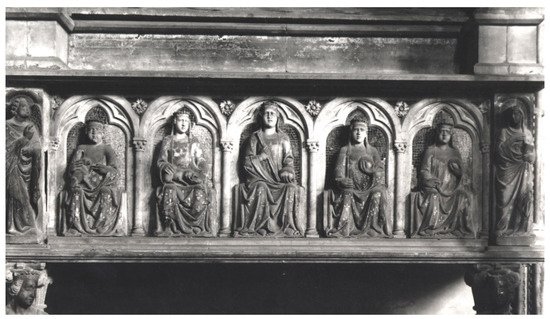
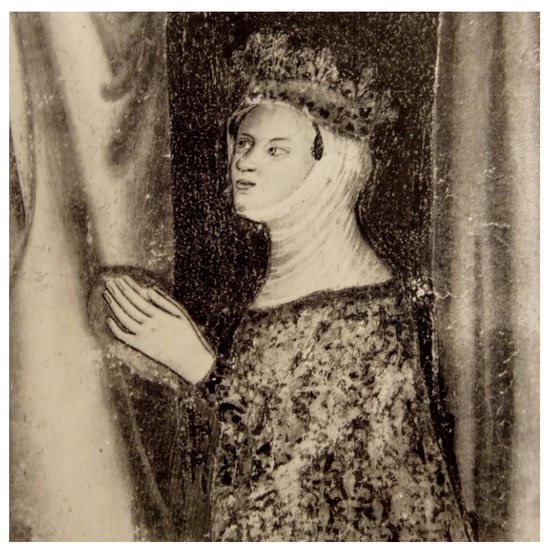
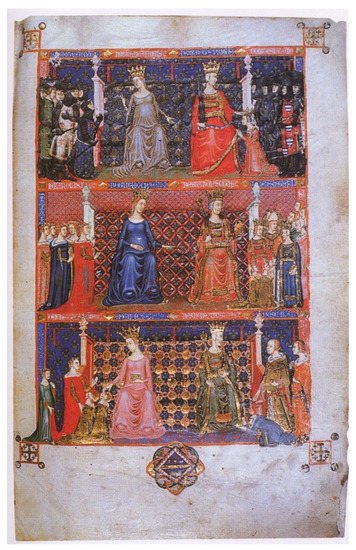
3. During Queenship
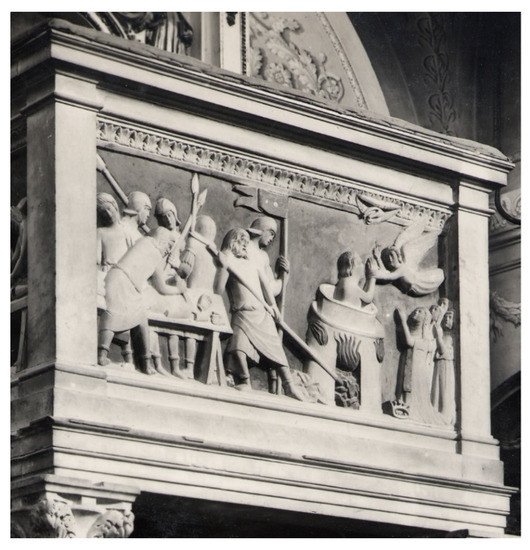
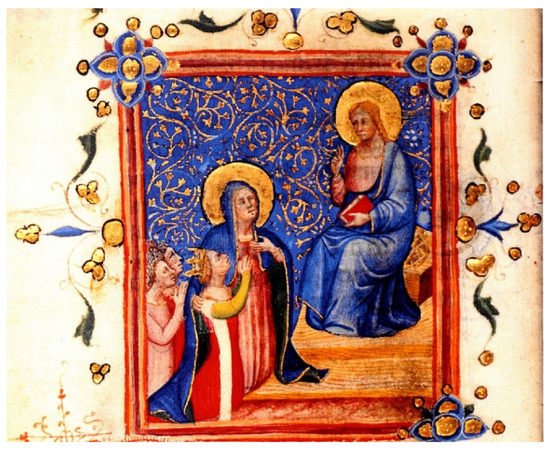
4. Conclusions
References
- Léonard, É.G. Histoire de Jeannere reine de Naples comtesse de Provence; August Picard: Paris, France, 1932.
- De Frede, C. Da Carlo I a Giovanna I d’Angiò 1263–1382. In Storia di Napoli. III; Edizioni Scientifiche Italiane: Naples, Italy, 1969; pp. 1–333, (pp. 225–322).
- Kiesewetter, A. Giovanna d’Angiò. In Dizionario Biografico degli Italiani; Istituto dell’Enciclopedia Italiana: Roma, Italy, 2000; Volume 55, pp. 455–477.
- Casteen, E. From She-Wolf to Martyr. The Reign and Disputed Reputation of Johanna I of Naples; Ithaca: London, UK, 2015.
- Musto, R.G. Writing Southern Italy before the Renaissance: Trecento Historians of the Mezzogiorno; Routledge: New York, NY, USA, 2019.
- de Castris, P.L. Arte di Corte Nella Napoli Angioina; Cantini: Firenze, Italy, 1989.
- Perriccioli Saggese, A. L’enluminure à Naples au temps des Anjou (1266–1350). In L’ Europe des Anjou. Aventure des Princes Angevins du XIIIe au XVe Siècle; (exposition catalogue, abbaye royale de Fontevraud, 15 June–16 September 2001); Somogy Éditions d’Art: Paris, France, 2001; pp. 123–133.
- Cioni, E. Per Giovanni di Ser Jacopo da Firenze, orafo di corte di Giovanna I d’Angiò. In Annali Della Scuola Normale Superiore di Pisa, Classe di Lettere e Filosofia. Quaderni; Scuola Normale Superiore: Pisa, Italy, 2000; pp. 87–102.
- Perriccioli Saggese, A. La miniatura in Italia meridionale in età angioina. In La Miniatura in Italia. I. Dal Tardoantico al Trecento con Riferimenti al Medio Oriente e all’Occidente Europeo; Putaturo Donati Murano, A., Perriccioli Saggese, A., Eds.; Edizioni Scientifiche Italiane: Napoli, Italy; Roma, Italy, 2005; pp. 235–246.
- Bräm, A. Neapolitanische Bilderbibeln des Trecento; Reichert: Wiesbaden, Germany, 2007.
- D’Urso, T. Un manoscritto di Boccaccio per Giovanna d’Angiò: Il De casibus virorum illustrium ms. ottob. lat. 2145 e il suo contesto. In Boccaccio e Napoli. Nuovi Materiali per la Storia Culturale di Napoli nel Trecento, Proceedings of the International Congress, Napoli, Salerno, Italy, 23–25 October 2013; Alfano, G., Grimaldi, E., Martelli, S., Mazzucchi, A., Palumbo, M., Saggese, A.P., Vecce, C., Eds.; Franco Cesati: Firenze, Italy, 2014; pp. 417–425.
- Leone de Castris, P. Gold, silver, gems and enamels in Naples under the Angevins, 1266–1381: Jewellery art at the Angevin court of Naples. In Ori, Argenti, Gemme e Smalti Della Napoli Angioina 1266–1381; Leone de Castris, P., Ed.; (exposition catalogue, 11 October–31 December 2014); Arte’m: Napoli, Italy, 2014; pp. 62–73.
- Vitolo, P. Imprese artistiche e modelli di regalità al femminile nella Napoli della prima età angioina. In Archivio Storico per le Province Napoletane; Società Napoletana di Storia Patria: Napoli, Italy, 2009; Volume 126, pp. 1–54.
- Bologna, F. I Pittori alla Corte Angioina di Napoli 1266-1414 e un Riesame dell’arte nell’età Fridericiana; Ugo Bozzi: Roma, Italy, 1969.
- Lucherini, V. Il refettorio e il capitolo del monastero maschile di S. Chiara: L’impianto topografico e le scelte decorative. In La Chiesa e il Convento di Santa Chiara. Committenza Artistica, vita Religiosa e Progettualità Politica Nella Napoli di Roberto d’Angiò e Sancia di Maiorca; Aceto, F., D’Ovidio, S., Scirocco, E., Eds.; Laveglia & Carlone: Battipaglia, Italy, 2014; pp. 385–430.
- Vagnoni, M. La Messa in Scena del Corpo Regio nel Regno di Sicilia. Federico III d’Aragona e Roberto d’Angiò; Basilicata University Press: Potenza, Italy, 2021.
- The Anjou Bible. A royal Manuscript Revealed. Naples 1340; Watteeuw, L.; Van der Stock, J. (Eds.) Peeters: Paris, France; Leuven, Belgium; Walpole, Australia, 2010.
- Perriccioli Saggese, A. Gli Statuti dell’Ordine dello Spirito Santo o del Nodo: Immagine e ideologia del potere regio a Napoli alla metà del Trecento. In Medioevo: Immagini e Ideologie, Proceedings of the International Congress, Parma, Italy, 23–27 September 2002; Quintavalle, A.C., Ed.; Electa: Milano, Italy, 2005; pp. 519–524.
- Vitolo, P. Immagini religiose e rappresentazione del potere nell’arte napoletana durante il regno di Giovanna I d’Angiò (1343-1382). In Immagini, Culti, Liturgie. Le Connotazioni Politiche del Messaggio religioso, Proceedings of the International Congress, Università Cattolica del Sacro Cuore di Milano, Milano, Italy, 1–3 October 2009; Gaffuri, L., Ventrone, P., Eds.; Annali di Storia Moderna e Contemporanea, Università Cattolica del Sacro Cuore: Milano, Italy, 2010; Volume 16, pp. 249–270.
- Bock, N. L’ Ordre du Saint—Esprit au Droit Désir: Enluminure, cérémonial et idéologie monarchique au XIVe siècle. In Art, Cérémonial et Liturgie au Moyen Age, Proceedings of the International Congress, Lausanne, Switzerland; Fribourg, Switzerland, 24–25 March, 14–15 April, 12–13 May 2002; Bock, N., Kurmann, P., Romano, S., Spieser, J.-M., Eds.; Viella: Roma, Italy, 2002; pp. 415–460.
- Enderlein, L. Die Gründungsgeschichte der “Incoronata” in Napoli. In Römisches Jahrbuch der Bibliotheca Hertziana; Hirmer Verlag: Munich, Germany, 1996; Volume 31, pp. 15–46.
- Vitolo, P. La Chiesa della Regina. Giovanna I d’Angiò, l’Incoronata di Napoli e Roberto di Oderisio; Roma: Viella, Italy, 2008.
- Ritzerfeld, U. Johanna I. und die Incoronata in Neapel: Weiblicher Herrschaftsanspruch in der Kirche der “regina dolorosa”. Mitt. Kunsthist. Inst. Florenz 2017, 59, 282–323.
- Perriccioli Saggese, A. Modelli giotteschi nella miniatura napoletana del Trecento. In Medioevo: I Modelli, Proceedings of the International Congress, Parma, Italy, 27 September–1 October 1999; Quintavalle, A.C., Ed.; Electa: Milano, Italy, 2002; pp. 661–667.
- Vitolo, P. Percorsi di Salvezza e Strumenti di Legittimazione. I Cicli dei Sette Sacramenti nell’arte del Medieoevo/Paths of Salvation and Instruments of Legitimation. Cycles of the Seven Sacraments in the Medieval Art; Gangemi: Roma, Italy, 2016.
- Ritzerfeld, U. Die “Ecclesia triumphans” in der Incoronata in Neapel: Bildbekenntnis zur Papstkirche von Johanna I. von Anjou. Iconographica 2017, 16, 94–114.
- Perriccioli Saggese, A. L’offiziolo di Giovanna I d’Angiò e un’inedita immagine di Brigida. In Santa Brigida, Napoli, l’Italia, Proceedings of the International Congress, Santa Maria Capua Vetere, Italy, 10–11 May 2006; Saggese, A.P., Ferm, O., Rotili, M., Eds.; Arte Tipografica: Napoli, Italy, 2009; pp. 221–240.
- Manzari, F. Le psautier et livre d’heures de Jeanne I d’Anjou: Pratiques françaises de dévotion et exaltation dynastique à la cour de Naples. In Art de L’enluminure; Éditions Faton: Paris, France, 2010; Volume 32, pp. 2–33.
- D’Urso, T. San Ludovico di Tolosa nei libri miniati, dal tempo di Roberto (1309-1343) a quello di Giovanna d’Angiò (1343–1381). In Da Ludovico d’Angiò a san Ludovico di Tolosa: I Testi e le Immagini, Proceedings of the International Congress, Napoli, Santa Maria Capua Vetere, Italy, 3–5 November 2016; D’Urso, T., Saggese, A.P., Solvi, D., Eds.; Fondazione Centro Italiano di Studi Sull’alto Medioevo: Spoleto, Italy, 2017; pp. 121–135.
- D’Urso, T. Mitologia, storia e letteratura nell’illustrazione libraria napoletana alla fine del regno di Giovanna I d’Angiò: Il Maestro delle Genealogiae deorum Add. 57529 della British Library. In Rivista di Storia Della Miniatura; Centro Di: Firenze, Italy, 2020; Volume 24, pp. 68–82.
- Lucherini, V. Celebrare e cancellare la memoria dinastica nella Napoli angioina: Le tombe del principe Andrea d’Ungheria e della regina Giovanna I. Hortus Artium Mediev. 2015, 21, 76–91.
